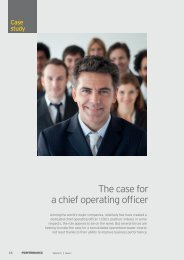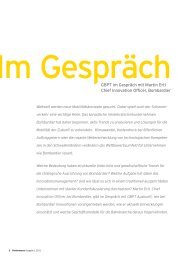PERF RMANCE 04 - The Performance Portal - Ernst & Young
PERF RMANCE 04 - The Performance Portal - Ernst & Young
PERF RMANCE 04 - The Performance Portal - Ernst & Young
Create successful ePaper yourself
Turn your PDF publications into a flip-book with our unique Google optimized e-Paper software.
“ Just like great farmers, their main task as coolfarmer is<br />
to provide a nurturing environment, and let the swarm<br />
do the work by itself.”<br />
listening first and foremost to themselves<br />
and to their swarm, instead of listening<br />
to management gurus, business school<br />
professors, and strategy consultants.<br />
<strong>The</strong>se leaders don’t just listen but immerse<br />
themselves into their swarm. While<br />
conventional businesses are scrambling, the<br />
businesses of these creators are thriving.<br />
Leaders like Oprah, Mark Zuckerberg, or<br />
Steve Jobs are not afraid to go to the front<br />
line every day, listening to what their swarm<br />
has to say. When Steve Jobs started Apple,<br />
instead of obtaining an MBA, he immersed<br />
himself into his swarm. He first listened<br />
to what others did in the same space,<br />
visiting world famous Xerox Parc research<br />
lab to learn about personal computers<br />
and computer mice, and landing a job at<br />
a computer company to learn even more,<br />
until he had figured it out and was ready to<br />
start building his own computers at Apple.<br />
<strong>The</strong>se creators also give back to their<br />
swarm. Google famously encourages its<br />
employees to be creative, come up with new<br />
product ideas which are then given away<br />
for free in some form until the company<br />
has figured out a way of making money<br />
from it. Google acquired picture sharing<br />
website Picasa, set up the social networking<br />
community Orkut, and converted a startup<br />
into Google Docs, the web-enabled office<br />
suite, all available free to users. When<br />
Steve Job’s swarm of fanatic iPhone<br />
owners complained about a new price cut,<br />
he immediately gave back the difference<br />
in price to anybody who had bought the<br />
iPhone at the old, higher price.<br />
In short, chief creative officers, other than<br />
conventional CEOs, immerse themselves<br />
into their swarm, they share with their<br />
swarm, and go where their swarm wants<br />
to go. Just like great farmers, their main<br />
task as coolfarmer is to provide a nurturing<br />
environment, and let the swarm do the<br />
work by itself.<br />
While these principles have been developed<br />
for “real” bricks-and-mortar organizations,<br />
they are no less valid in the virtual world,<br />
where they allow the identification of<br />
hidden leaders and innovators in online<br />
social networks such as Facebook and<br />
online forums. <strong>The</strong>se leaders can then<br />
be recruited as lead users and extended<br />
members of a product development team.<br />
I would now like to illustrate these concepts<br />
by describing two case studies, based<br />
on my actual projects, which have been<br />
ongoing for the last few years.<br />
Healthcare case study:<br />
creating Collaborative<br />
Chronic Care Networks<br />
(C3N) by connecting online<br />
social networks<br />
Collaborative Chronic Care Networks (C3N)<br />
are based on the concept of Collaborative<br />
Innovation Networks (COINs). COINs are a<br />
radically new concept to chronic illness care<br />
and, while many use the web for health<br />
information, existing health-related social<br />
networks separate patients from providers,<br />
despite the fact that patient-provider<br />
interaction is key to chronic illness care.<br />
In this project, a team of medical<br />
researchers collaborates with patients of<br />
a chronic disease, their family members,<br />
their doctors and other researchers. <strong>The</strong><br />
goal of the project is to improve the living<br />
conditions of people with Crohn’s disease,<br />
also called inflammatory bowel disease<br />
(IBD), which affects about 100,000 young<br />
people in the United States. Toward that<br />
goal, a small group of about 20 medical<br />
researchers, doctors and patients works<br />
together as a COIN. <strong>The</strong>y are reaching out<br />
to Crohn’s patients on Facebook, where<br />
about 100,000 people are organized in<br />
about a dozen Facebook groups (see<br />
Figure 1). Members of these groups are<br />
recruited as volunteers for patient data<br />
collection, and to get advice on what works<br />
and doesn’t for patients in their daily lives.






